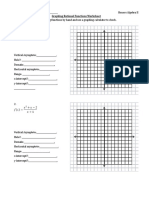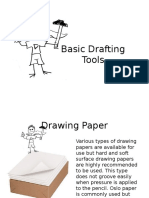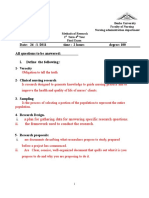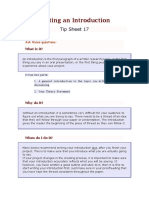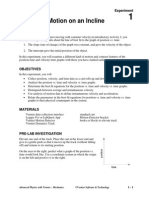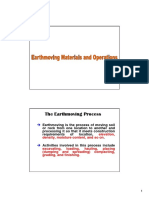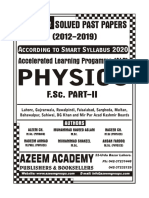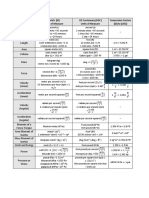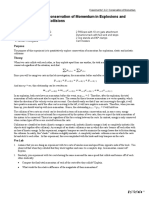Horizontal Projectile Motion: Objective: Predict Where Your Ball Will Land!
Horizontal Projectile Motion: Objective: Predict Where Your Ball Will Land!
Uploaded by
Leznan DayCopyright:
Available Formats
Horizontal Projectile Motion: Objective: Predict Where Your Ball Will Land!
Horizontal Projectile Motion: Objective: Predict Where Your Ball Will Land!
Uploaded by
Leznan DayOriginal Description:
Original Title
Copyright
Available Formats
Share this document
Did you find this document useful?
Is this content inappropriate?
Copyright:
Available Formats
Horizontal Projectile Motion: Objective: Predict Where Your Ball Will Land!
Horizontal Projectile Motion: Objective: Predict Where Your Ball Will Land!
Uploaded by
Leznan DayCopyright:
Available Formats
Horizontal Projectile Motion
Horiz ontal projectile motion is one of the most basic examples of classical physics. Gravity is a force
that causes acceleration towards the center of the Earth at 9.81 m/s 2. This causes objects that are
falling to increase in speed until they reach their t erminal, or maximum, velocity (or until they are
stopped by another force, like hitting the ground). Horiz ontal motion, however, is a good example of
Newtonian physics: things in motion stay in motion unless acted upon by another force. If an object is
traveling horiz ontally, it tends to travel horiz ontally at the same speed until another force changes its
motion.
In this experiment, you will build a ramp and use that to project a ball off the table. You'll calculate the
ball's velocity to determine how far the ball will travel, allowing you to anticipate the ball's trajectory and
place your target in the perfect spot.
Objective: Predict where your ball will land!
Mat erials
Empty wrapping paper tube
Tape
Books to stack
Stopwatch
Box cutter
Ping pong ball or rubber ball
Table
Meter stick
Pape
Markers
Procedure
1. Have an adult use the box cutter to cut the cardboard tube in half to create the ramp.
2. While they are cutting, use the piece of paper to draw a target. You will be trying to get to ball to
land on the target on the floor, as accurately as possible.
3. Stack some books on a table and tape the top of the cardboard tube to the book top to make
the ramp. Leave a bit of space at the end of the table as shown below. Why is this important?
4 . Measure the length of the ramp.
5. Use the stopwatch to time how long it takes for the ball to slide down the ramp. Use this time to
calculate the velocity the ball will have when it goes over the edge of the table:
where v is velocity in meters per second, d is the length of the ramp in meters, and t is the time it
takes for the ball to reach the end of the ramp, in seconds.
6. It may be helpful to take your time measurement several times and then calculate a velocity.
7. Measure the height of the table to the ground. Using the acceleration of gravity and a starting
velocity of z ero m/s, calculate how long it will take the ball to fall to the ground. You can do so
using the following equation:
Where t is time, h is height, and g is gravitational acceleration, or 9.8 meters per second per second.
8. Now, calculate the distance the ball will travel before hitting the ground (R). Simply multiply the
balls velocity by the time you calculated in step 7. Place your target at this distance away from
the edge of the table!
Result s
If your calculations are correct, you will be very close to hitting the bulls-eye of your target. Because
the ball does not travel very far, the horiz ontal velocity loss due to friction will be very small.
Why?
The horiz ontal space below the ramp is crucial to the experiment because it ensures that the vertical
component of the ball velocity is z ero when the ball leaves the table. This allows us to calculate the
time it will take to hit the floor using only the height of the table and the acceleration due to gravity.
You might also like
- Graphing Rational Functions Ws - Docx 2Document4 pagesGraphing Rational Functions Ws - Docx 2محمد أحمد عبدالوهاب محمدNo ratings yet
- UCLA Physics 6A SyllabusDocument4 pagesUCLA Physics 6A SyllabusJClouseyNo ratings yet
- Lesson Plans For Introduction To Office Productivity Oct 10s-14 16Document4 pagesLesson Plans For Introduction To Office Productivity Oct 10s-14 16api-297803307No ratings yet
- CH 3 Measurement and DataDocument42 pagesCH 3 Measurement and DatadashanNo ratings yet
- Sample Weighted RubricDocument1 pageSample Weighted Rubricapi-287380814100% (1)
- Motion in One DimensionDocument12 pagesMotion in One DimensionShinji50% (2)
- Global WarmingDocument5 pagesGlobal WarmingAshwini KumarNo ratings yet
- Operation Sheet 2.2: Learning Outcome 2Document16 pagesOperation Sheet 2.2: Learning Outcome 2Paul Senen DiduloNo ratings yet
- FIBA Rules Changes From 1 10 2022 v1 0a enDocument27 pagesFIBA Rules Changes From 1 10 2022 v1 0a enMaybelle Aggabao100% (1)
- Possible Thesis Defense QuestionsDocument3 pagesPossible Thesis Defense QuestionsApple ArgameNo ratings yet
- Reflection and Refraction of LightDocument4 pagesReflection and Refraction of LightMaxNo ratings yet
- Gabriel Taborin College of DavaoDocument5 pagesGabriel Taborin College of DavaoAdrian Baguna MontemorNo ratings yet
- Q3 Health 8 Module 5 PDFDocument13 pagesQ3 Health 8 Module 5 PDFkateNo ratings yet
- LeaP Science G8 Week 3 Q3Document4 pagesLeaP Science G8 Week 3 Q3Hydeelyn BringasNo ratings yet
- Difficulties On Modular Delivery Learning Experienced by The Grade 11 Students 1Document12 pagesDifficulties On Modular Delivery Learning Experienced by The Grade 11 Students 1William RañosaNo ratings yet
- Prof Ed HandoutsDocument18 pagesProf Ed Handoutsanon_297246084No ratings yet
- Mechanical DraftingDocument33 pagesMechanical DraftingJudithNo ratings yet
- Updated Thesis GuidelinesDocument19 pagesUpdated Thesis GuidelinesjthsNo ratings yet
- Drafting ToolsDocument15 pagesDrafting ToolsRhon T. BergadoNo ratings yet
- A Report On Problems Faced by Students in Online Distance LearningDocument13 pagesA Report On Problems Faced by Students in Online Distance Learningmaibed99No ratings yet
- Nstp-Drug Addiction-1Document4 pagesNstp-Drug Addiction-1Jhyrha Camille FelixNo ratings yet
- Research: Levita Blorecia-Grana, DM, CE SjitDocument56 pagesResearch: Levita Blorecia-Grana, DM, CE Sjitrex hussein lamosteNo ratings yet
- Quiz BowlDocument36 pagesQuiz BowlSherry GonzagaNo ratings yet
- Proposal Procrastination Issues Among StudentsDocument7 pagesProposal Procrastination Issues Among StudentsAi sham0% (1)
- Learning Area Grade Level Quarter Date I. Lesson Title Ii. Most Essential Learning Competencies (Melcs) Iii. Content/Core ContentDocument5 pagesLearning Area Grade Level Quarter Date I. Lesson Title Ii. Most Essential Learning Competencies (Melcs) Iii. Content/Core ContentYne AhuninNo ratings yet
- 1Document87 pages1xubrylleNo ratings yet
- First Periodic Exam in Tle 7-IctDocument3 pagesFirst Periodic Exam in Tle 7-IctCanduman NhsNo ratings yet
- NSTP 1 (Lessons 1-3)Document24 pagesNSTP 1 (Lessons 1-3)Kyla VillamorNo ratings yet
- What Is PhotographyDocument7 pagesWhat Is PhotographyNhan Sie100% (1)
- Orthographic ProjectionDocument9 pagesOrthographic ProjectionDoc BryNo ratings yet
- Golden Ratio InvestigationsDocument4 pagesGolden Ratio InvestigationsandreastatlerNo ratings yet
- Familiarization of Lab ApparatusesDocument7 pagesFamiliarization of Lab ApparatusesAbby GutierrezNo ratings yet
- Critique PaperDocument6 pagesCritique PaperTheodoro YasonNo ratings yet
- Lecture Notes 8A Testing of HypothesisDocument11 pagesLecture Notes 8A Testing of HypothesisFrendick Legaspi100% (1)
- Devc. 202 Tma #2Document9 pagesDevc. 202 Tma #2Jeanette Laila BusanoNo ratings yet
- Model Answer of 2 Old Methods of Research ExamDocument10 pagesModel Answer of 2 Old Methods of Research ExamKelvinBolasocNo ratings yet
- Comparing Quantitative and Qualitative ResearchDocument2 pagesComparing Quantitative and Qualitative ResearchImanNo ratings yet
- Symmetry Lesson PlanDocument4 pagesSymmetry Lesson Planapi-518728602No ratings yet
- PR1Q3 ReviewerDocument7 pagesPR1Q3 ReviewerIt’s yanaNo ratings yet
- Surigao Del Sur Division Hinatuan West DistrictDocument3 pagesSurigao Del Sur Division Hinatuan West DistrictSquirmy Cape9097No ratings yet
- Portfolio in Work ImmerssionDocument12 pagesPortfolio in Work ImmerssionSherren Marie NalaNo ratings yet
- Introduction To Drafting Tools PDFDocument19 pagesIntroduction To Drafting Tools PDFKareen Carlos GerminianoNo ratings yet
- Good Morning Students!Document61 pagesGood Morning Students!MOCHI 933No ratings yet
- Grade 10 Drafting Design Technology (20G) : A Course For Independent StudyDocument38 pagesGrade 10 Drafting Design Technology (20G) : A Course For Independent StudyLanggeng PrasetyoNo ratings yet
- Techniques For Measuring Oral ProficiencyDocument393 pagesTechniques For Measuring Oral ProficiencyYasmine HaciniNo ratings yet
- Digital PhotographyDocument33 pagesDigital Photographysome kirstenNo ratings yet
- Parents Rearing A ChildDocument30 pagesParents Rearing A ChildIsabel BantayanNo ratings yet
- Beach Volleyball Rules PDFDocument2 pagesBeach Volleyball Rules PDFmaria3180No ratings yet
- QuestionnaireDocument5 pagesQuestionnaireChezkie EmiaNo ratings yet
- Dcit 60 ReviewerDocument5 pagesDcit 60 ReviewerMark Nathan BatulaNo ratings yet
- Reading Books or Watching TV - JasonDocument1 pageReading Books or Watching TV - JasonSophia LaiNo ratings yet
- Experiment 402 Plane and Spherical Mirrors (Analysis and Conclusion)Document2 pagesExperiment 402 Plane and Spherical Mirrors (Analysis and Conclusion)zidrick benjaminNo ratings yet
- Seeking The Light From The Smoke: A Case Study of Chain Smokers On Smoking Cessation in Mandaue City, PhilippinesDocument10 pagesSeeking The Light From The Smoke: A Case Study of Chain Smokers On Smoking Cessation in Mandaue City, PhilippinesPsychology and Education: A Multidisciplinary Journal100% (1)
- ICT Grade 7 2ndDocument7 pagesICT Grade 7 2ndRhayan Dela Cruz DaquizNo ratings yet
- Infrared WavesDocument13 pagesInfrared WavesJoaquin ReyesNo ratings yet
- Writing An IntroductionDocument9 pagesWriting An IntroductionSarah AgonNo ratings yet
- Monsoon S: Wind System: (Amihan and Habagat) ItczDocument22 pagesMonsoon S: Wind System: (Amihan and Habagat) ItczJovi AbabanNo ratings yet
- Aspects of Qualitative Research InterviewsDocument5 pagesAspects of Qualitative Research InterviewsJitendra Singh RajawatNo ratings yet
- 1Document9 pages1MCHNo ratings yet
- Environmental AdvocacyDocument15 pagesEnvironmental AdvocacyAlyzza Kara AcabalNo ratings yet
- Horizontal Projectile Motion ExperimentDocument3 pagesHorizontal Projectile Motion Experimentbookdotcom7221No ratings yet
- Horizontal Projectile MotionDocument2 pagesHorizontal Projectile MotionnethraNo ratings yet
- The Cave of SafetyDocument2 pagesThe Cave of SafetyLeznan DayNo ratings yet
- Seful Onversions: Energy Conversions 1 CM 1 X CMDocument1 pageSeful Onversions: Energy Conversions 1 CM 1 X CMLeznan DayNo ratings yet
- Projectile Motion Lab RevisedDocument7 pagesProjectile Motion Lab RevisedLeznan DayNo ratings yet
- Motion On An Incline: ExperimentDocument4 pagesMotion On An Incline: ExperimentLeznan DayNo ratings yet
- Newton Law of CoolingDocument4 pagesNewton Law of CoolingLeznan DayNo ratings yet
- N.C.E.A 90521-Exm-2012Document12 pagesN.C.E.A 90521-Exm-2012Asrarul Haque ObaidullahNo ratings yet
- CIVL462 ExcavationDocument19 pagesCIVL462 ExcavationfajriNo ratings yet
- NewScientist - Poster of RealityDocument1 pageNewScientist - Poster of Realityoaky100% (2)
- Cambridge International Examinations Cambridge Pre-U CertificateDocument16 pagesCambridge International Examinations Cambridge Pre-U Certificatelaksh bissoondialNo ratings yet
- Module Grade 8 Science First Quarter 2021Document22 pagesModule Grade 8 Science First Quarter 2021juliusvaldez07201996No ratings yet
- Prepared by Dr. Salam SakrDocument70 pagesPrepared by Dr. Salam Sakrali hajNo ratings yet
- Unit 5. Forces: 1. Forces and Their Effects 2. Simple Machines 3. Types of Forces 4. Common ForcesDocument31 pagesUnit 5. Forces: 1. Forces and Their Effects 2. Simple Machines 3. Types of Forces 4. Common ForcesgenusxyzNo ratings yet
- Chapter 22 Electric FieldsDocument3 pagesChapter 22 Electric FieldsShaker Ullah Chowdhury100% (1)
- 2nd Year Physics PPDocument104 pages2nd Year Physics PPAdnanNo ratings yet
- A Detailed Lesson Plan in MomentumDocument5 pagesA Detailed Lesson Plan in MomentumBryanJAbulocNo ratings yet
- Chapter 1: Atoms and Elements: KTT 111/3 - Inorganic Chemistry IDocument31 pagesChapter 1: Atoms and Elements: KTT 111/3 - Inorganic Chemistry INur Syazwani RozmanNo ratings yet
- Dynamic Carts Study Guide: F M X ADocument6 pagesDynamic Carts Study Guide: F M X AKenneth ReditaNo ratings yet
- Quantity Metric (SI) Units of Measure US Customary (USC) Units of Measure Conversion Factors (SI) To (USC)Document1 pageQuantity Metric (SI) Units of Measure US Customary (USC) Units of Measure Conversion Factors (SI) To (USC)Aadarsh bhandariNo ratings yet
- ExperimentDocument6 pagesExperimentAli SirNo ratings yet
- Energy Consideration in Planetary and Satellite Motion?Document3 pagesEnergy Consideration in Planetary and Satellite Motion?Bloom Arshad100% (4)
- Physics SBA 4Document3 pagesPhysics SBA 4annmarieNo ratings yet
- A Brief History of ElectromagnetismDocument2 pagesA Brief History of ElectromagnetismpainteramitNo ratings yet
- Edexcel Physics Coursework ExamplesDocument7 pagesEdexcel Physics Coursework Examplesf5dt39tp100% (2)
- Science-8-Q1-Mod1-Force, Motion - EnergyDocument27 pagesScience-8-Q1-Mod1-Force, Motion - EnergyAngelica BuquiranNo ratings yet
- Fitness Progress Chart For Men (Metric)Document4 pagesFitness Progress Chart For Men (Metric)Marius MitricăNo ratings yet
- Friction ProblemsDocument6 pagesFriction ProblemsNopmangunawan100% (1)
- Civil Engineering Mechanics CVG2149: Kinematics of Rigid Bodies (CH. 15)Document8 pagesCivil Engineering Mechanics CVG2149: Kinematics of Rigid Bodies (CH. 15)Kaiss Nael OsmanNo ratings yet
- Course Outline of Applied Physics by Tahseen SanaDocument2 pagesCourse Outline of Applied Physics by Tahseen SanaTahseen SanaNo ratings yet
- Adding Forces Resultant and Equilibrium, Resolving Forces ComponentDocument18 pagesAdding Forces Resultant and Equilibrium, Resolving Forces ComponentHisyamAl-MuhammadiNo ratings yet
- CH 5Document41 pagesCH 5prince1004No ratings yet
- Archimedes PrincipleDocument4 pagesArchimedes PrincipleSyifa Mahadi100% (3)
- Physics Topic 23 Review Long Qs 24q68opDocument14 pagesPhysics Topic 23 Review Long Qs 24q68opVijay BhaskarNo ratings yet
